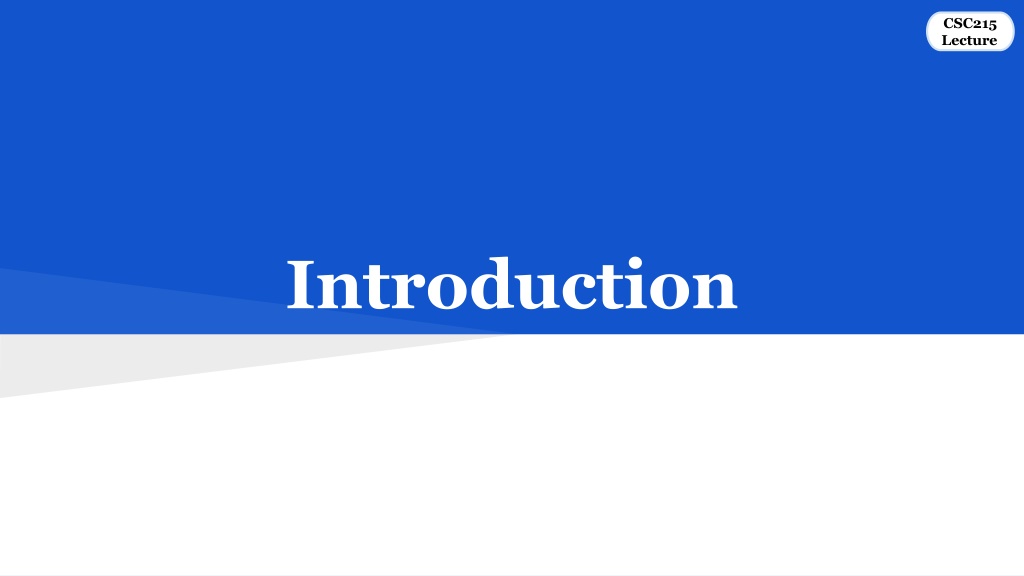
Overview of C Programming Languages and Concepts
Explore the history, features, and programming paradigms related to C programming languages, including object-oriented and procedural programming. Understand the importance of choosing the right tool for the job among the plethora of programming languages available.
Download Presentation

Please find below an Image/Link to download the presentation.
The content on the website is provided AS IS for your information and personal use only. It may not be sold, licensed, or shared on other websites without obtaining consent from the author. If you encounter any issues during the download, it is possible that the publisher has removed the file from their server.
You are allowed to download the files provided on this website for personal or commercial use, subject to the condition that they are used lawfully. All files are the property of their respective owners.
The content on the website is provided AS IS for your information and personal use only. It may not be sold, licensed, or shared on other websites without obtaining consent from the author.
E N D
Presentation Transcript
CSC215 Lecture Introduction
Outline Programming Languages Object Oriented Programming Procedural Programming What is C? Short history Features, Strengths and weaknesses Relationships to other languages Writing C Programs Editing Compiling Structure of C Programs Comments Variables Functions: main, function prototypes and functions Expressions and Statements
Programming Languages Many programming languages exist, each intended for a specific purpose Over 700 programming language entries on wikipedia Should we learn all? Which is the best language? None! Choose the right tool for the job based on: problem scope, target hardware/software, memory and performance considerations, portability, concurrency.
Object Oriented Programming Very useful to organize large software projects The program is organized as classes The data is broken into objects and the sequence of commands becomes the interactions between objects: Decide which classes you need provide a full set of operations for each class and make commonality explicit by using inheritance. Covered in CSC111 and CSC113
Procedural Programming The program is divided up into subroutines or procedures Allows code to become structured The programmer must think in terms of actions: decide which procedures and data structures you want Procedural languages include: Fortran BASIC Pascal C
What is C? History: 1972 - Dennis Ritchie AT&T Bell Laboratories 16-bit DEC PDP-11 computer (right) 1978 - Published; first specification of language 1989 - C89 standard (known as ANSI C or Standard C) 1990 - ANSI C adopted by ISO, known as C90 1999 - C99 standard: mostly backward-compatible, not completely implemented in many compilers 2007 - work on new C standard C1X announced In this course: ANSI/ISO C (C89/C90)
What is C? Features: Provides low -level access to memory Provides language constructs that map efficiently to machine instructions Few keywords (32 in ANSI C) Structures, unions compound data types Pointers - memory, arrays External standard library I/O, other facilities Compiles to native code Systems programming: OSes, like Linux microcontrollers: automobiles and airplanes embedded processors: phones, portable electronics, etc. DSP processors: digital audio and TV systems . . . Macro preprocessor Widely used today, Extends to newer system architectures
What is C? Strengths: Efficiency: intended for applications where assembly language had traditionally been used Portability: hasn t splintered into incompatible dialects; small and easily written Power: large collection of data types and operators Flexibility: not only for system but also for embedded system commercial data processing Standard library Integration with UNIX Weaknesses Error-prone: Error detection left to the programmer Difficult to understand Large programmes Difficult to modify
Relationship to Other Languages More recent derivatives: C++, Objective C, C# Influenced: Java, Perl, Python (quite different) C lacks: Exceptions Range-checking Memory management and garbage collection. Objects and object-oriented programming Polymorphism Shares with Java: /* Comments */ Variable declarations if / else statements for / while loops function definitions (like methods) Main function starts program
C Programs Editing: C source code files has .c extension Text files that can be edited using any text editor: Example product.c #include <stdio.h> main() { int a, b, c; a = 3; b = 2; c = a * b; printf( The product is %d , c); } Compiling: gcc -o product product.c -o place the output in file product product is the executable file To execute the program: product on windows or ./product on Linux and Linux-like
C Compilers Several compilers Microsoft compiler GNU Compiler Collection (GCC) : (see a List of C compilers) How to install GCC on windows: MinGW: from https://nuwen.net/mingw.html Cygwin: from https://cygwin.com/install.html Don t forget to update the path! Compilation options: gcc -ansi product.c gcc -Wall product.c In this course we will always use: gcc -Wall -ansi -o product product.c : : check the program compatibility with ANSI C enables all the warnings that are easy to avoid Cross Compilation: compiling on one platform to run on another
Structure of .c File /* Begin with comments about file contents */ /* Insert #include statements and preprocessor definitions */ /* Function prototypes and variable declarations */ /* Define main() function { Function body } */ /* Define other function(s) { Function body } */
Structure of .c File: Comments / this is a simple comment / Can span multiple lines / This comment Spans m u l t i p l e l i n e s / Completely ignored by compiler Can appear almost anywhere| / h e l l o . c our f i r s t C program Created for CSC215 /
Structure of .c File: #include Preprocessor #include is a preprocessor: Header files: constants, functions, other declarations #include: read the contents of the header file stdio.h stdio.h: standard I/O functions for console and files #include <stdio.h> / basic I/O facilities */ stdio.h part of the C Standard Library other important header files: assert.h ctype.h errno.h signal.h setjmp.h stdarg.h Included files must be on include path standard include directories assumed by default #include "stdio.h" searches ./ for stdio.h first float.h stddef.h limits.h stdlib.h locale.h string.h math.h time.h
Structure of .c File: #Variables and Constants Variables: named spaces in memory that hold values Refer to these spaces using their names rather than memory addresses Names selection adheres to some rules Defined with a type that determines their domains and operations Variable must be declared prior to their use Can change their values after initialization Constants: Do not change their values after initialization Can be of any basic or enumerated data type Declared by assigning a literal to a typed name, with the use of the keyword const const int LENGTH = 10; Const char NEWLINE = '\n'; Can also use the #define preprocessor #define LENGTH 10
Structure of .c File: Function Prototype Functions also must be declared before use Declaration called function prototype Function prototypes: int factorial(int); int factorial(int n); Prototypes for many common functions in header files for C Standard Library General form: return_type function_name(arg1,arg2,...); Arguments: local variables, values passed from caller Return value: single value returned to caller when function exits void signifies no return value/arguments int rand(void);
Structure of .c File: Function main main(): entry point for C program Simplest version: no inputs, outputs 0 when successful, and nonzero to signal some error int main(void); Two-argument form of main(): access command-line arguments int main(int argc, char argv); More on the char **argv notation later
Structure of .c File: Function Definitions Function declaration <return_type> <function_name>(<list_of_parameters>){ <declare_variables;> <program_statements;> return <expression>; } Must match prototype (if there is one) variable names don t have to match No semicolon at end Curly braces define a block region of code Variables declared in a block exist only in that block Variable declarations before any other statements
Console Input and Output stdout, stdin: console output and input streams puts(<string_expression>): prints string to stdout putchar(<char_expression>): prints character to stdout <char_var> = getchar(): returns character from stdin <string_var> = gets(<buffer>): reads line from stdin into string printf(control_string, arg1, arg2, ) to be discussed later
Structure of .c File: Expressions and statements Expression: a sequence of characters and symbols that can be evaluated to a single data item. consists of: literals, variables, subexpressions, interconnected by one or more operators Numeric literals like 3 or 4.5 String literals like Hello Example expressions: Binary arithmetic x+y , x-y , x*y , x/y , x%y Statement: A sequence of characters and symbols causes the computer to carry out some definite action Not all statements have values Example statement: y = x+3 x/(y 4); Semicolon ends statement (not newline)
Output Statements / The main ( ) function / int main (void)/ entry point / { / write message to console / puts( "Hello World!" ); return 0; / exit (0 => success) / } puts(<string>): output text to console window (stdout) and end the line String literal: written surrounded by double quotes return 0; exits the function, returning value 0 to caller




